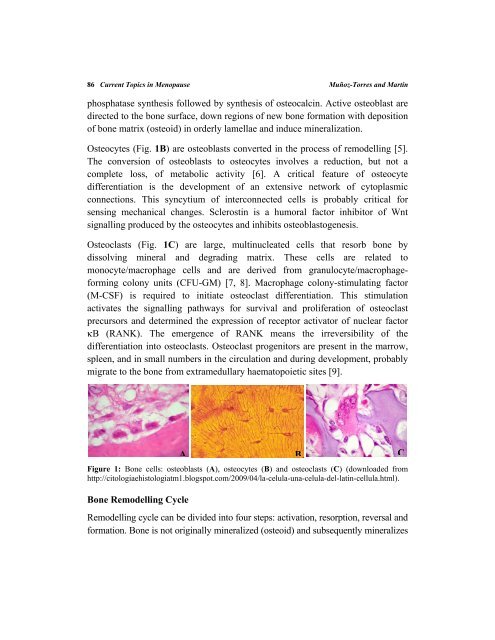Download - Bentham Science
Download - Bentham Science
Download - Bentham Science
You also want an ePaper? Increase the reach of your titles
YUMPU automatically turns print PDFs into web optimized ePapers that Google loves.
86 Current Topics in Menopause Muñoz-Torres and Martín<br />
phosphatase synthesis followed by synthesis of osteocalcin. Active osteoblast are<br />
directed to the bone surface, down regions of new bone formation with deposition<br />
of bone matrix (osteoid) in orderly lamellae and induce mineralization.<br />
Osteocytes (Fig. 1B) are osteoblasts converted in the process of remodelling [5].<br />
The conversion of osteoblasts to osteocytes involves a reduction, but not a<br />
complete loss, of metabolic activity [6]. A critical feature of osteocyte<br />
differentiation is the development of an extensive network of cytoplasmic<br />
connections. This syncytium of interconnected cells is probably critical for<br />
sensing mechanical changes. Sclerostin is a humoral factor inhibitor of Wnt<br />
signalling produced by the osteocytes and inhibits osteoblastogenesis.<br />
Osteoclasts (Fig. 1C) are large, multinucleated cells that resorb bone by<br />
dissolving mineral and degrading matrix. These cells are related to<br />
monocyte/macrophage cells and are derived from granulocyte/macrophageforming<br />
colony units (CFU-GM) [7, 8]. Macrophage colony-stimulating factor<br />
(M-CSF) is required to initiate osteoclast differentiation. This stimulation<br />
activates the signalling pathways for survival and proliferation of osteoclast<br />
precursors and determined the expression of receptor activator of nuclear factor<br />
B (RANK). The emergence of RANK means the irreversibility of the<br />
differentiation into osteoclasts. Osteoclast progenitors are present in the marrow,<br />
spleen, and in small numbers in the circulation and during development, probably<br />
migrate to the bone from extramedullary haematopoietic sites [9].<br />
A<br />
B<br />
C<br />
Figure 1: Bone cells: osteoblasts (A), osteocytes (B) and osteoclasts (C) (downloaded from<br />
http://citologiaehistologiatm1.blogspot.com/2009/04/la-celula-una-celula-del-latin-cellula.html).<br />
Bone Remodelling Cycle<br />
Remodelling cycle can be divided into four steps: activation, resorption, reversal and<br />
formation. Bone is not originally mineralized (osteoid) and subsequently mineralizes
















